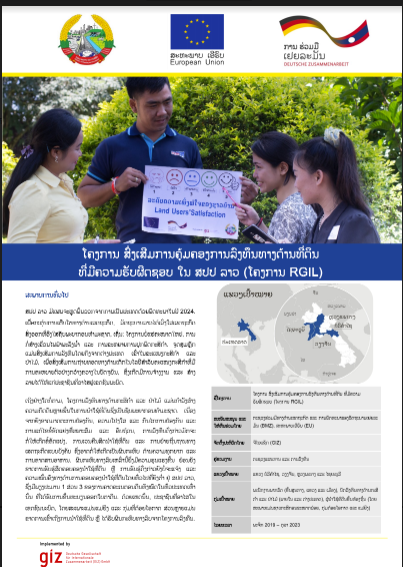ໂຄງການ ສ ົ່ງເສີມການຄ ້ມຄອງການລ ງທຶນທາງດ້ານທີື່ດິນ ທີື່ມີຄວາມຮັບຜິດຊອບ ໃນ ສປປ ລາວ (ໂຄງການ RGIL)
ສປປ ລາວ ມີແຜນຈະຫ ຼຸດພ ົ້ນອອກຈາກການເປັນປະເທດດ້ອຍພັດທະນາໃນປີ2024.ເພ ື່ອກະຕ ້ນການເຕີບໂຕທາງດ້ານເສດຖະກິດ, ລັດຖະບານລາວໄດ້ເລັົ່ງໃສ່ເສດຖະກິດ ສ ົ່ງອອກທີື່ອີງໃສ່ຊັບພະຍາກອນທໍາມະຊາດ, ເຊັົ່ນ: ໂຄງການບ ໍ່ແຮ່ຂະຫນາດໃຫຍ່, ການ ກ ໍ່ສ້າງເຂ ື່ອນໄຟຟ້າພະລັງນໍ້າ ແລະ ການຂະຫຍາຍການປູກພ ດກະສິກໍາ. ຈ ດສ ມຫ ັກ
ແມ່ນສ ົ່ງເສີມການລ ງທຶນໂດຍກ ງຈາກຕ່າງປະເທດ ເຂ ົ້າໃນຂະແຫນງກະສິກໍາ ແລະ ປ່າໄມ້, ເພ ື່ອສ ົ່ງເສີມການຖ່າຍທອດທາງດ້ານເຕັກໂນໂລຢີສໍາລັບຂະແຫນງກະສິກໍາທີື່ມີ ການຂະຫຍາຍຕ ວຢ່າງກວ້າງຂວາງໃນປັດຈ ບັນ, ຊຶື່ງເກີດມີການຈ້າງງານ ແລະ ສ້າງ












